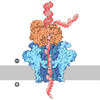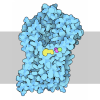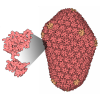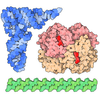+ Open data
Open data
- Basic information
Basic information
| Entry | Database: PDB / ID: 9hjm | ||||||
|---|---|---|---|---|---|---|---|
| Title | Porphyromonas gingivalis BAM complex | ||||||
 Components Components |
| ||||||
 Keywords Keywords | MEMBRANE PROTEIN / Outer membrane biogenesis / beta-barrel assembly machinery / BAM / Gram-negative bacteria | ||||||
| Function / homology |  Function and homology information Function and homology informationmembrane assembly / peptidylprolyl isomerase / peptidyl-prolyl cis-trans isomerase activity / cell outer membrane Similarity search - Function | ||||||
| Biological species |  Porphyromonas gingivalis ATCC 33277 (bacteria) Porphyromonas gingivalis ATCC 33277 (bacteria) | ||||||
| Method | ELECTRON MICROSCOPY / single particle reconstruction / cryo EM / Resolution: 3.24 Å | ||||||
 Authors Authors | Madej, M. / Silale, A. / van den Berg, B. | ||||||
| Funding support |  Poland, 1items Poland, 1items
| ||||||
 Citation Citation |  Journal: Nat Microbiol / Year: 2025 Journal: Nat Microbiol / Year: 2025Title: Structure of a distinct β-barrel assembly machinery complex in the Bacteroidota. Authors: Augustinas Silale / Mariusz Madej / Katarzyna Mikruta / Andrew M Frey / Adam J Hart / Arnaud Baslé / Carsten Scavenius / Jan J Enghild / Matthias Trost / Robert P Hirt / Bert van den Berg /    Abstract: The Gram-negative β-barrel assembly machinery (BAM) complex catalyses the folding and membrane insertion of newly synthesized β-barrel outer membrane proteins. The BAM is structurally conserved, ...The Gram-negative β-barrel assembly machinery (BAM) complex catalyses the folding and membrane insertion of newly synthesized β-barrel outer membrane proteins. The BAM is structurally conserved, but most studies have focused on Gammaproteobacteria. Here, using single-particle cryogenic electron microscopy, quantitative proteomics and functional assays, we show that the BAM complex is distinct within the Bacteroidota. Cryogenic electron microscopy structures of BAM complexes from the human gut symbiont Bacteroides thetaiotaomicron (3.3 Å) and the human oral pathogen Porphyromonas gingivalis (3.2 Å) show similar, seven-component complexes of ~325 kDa. The complexes are mostly extracellular and comprise canonical BamA and BamD; an integral, essential outer membrane protein, BamG, that associates with BamA; and four surface-exposed lipoproteins: BamH-K. Absent from the BAM in Pseudomonadota, BamG-K form a large, extracellular dome that may confer additional functionality to enable the folding and assembly of β-barrel-surface-exposed lipoprotein complexes that are a hallmark of the Bacteroidota. Our findings develop our understanding of fundamental biological processes in an important bacterial phylum. | ||||||
| History |
|
- Structure visualization
Structure visualization
| Structure viewer | Molecule:  Molmil Molmil Jmol/JSmol Jmol/JSmol |
|---|
- Downloads & links
Downloads & links
- Download
Download
| PDBx/mmCIF format |  9hjm.cif.gz 9hjm.cif.gz | 405.6 KB | Display |  PDBx/mmCIF format PDBx/mmCIF format |
|---|---|---|---|---|
| PDB format |  pdb9hjm.ent.gz pdb9hjm.ent.gz | Display |  PDB format PDB format | |
| PDBx/mmJSON format |  9hjm.json.gz 9hjm.json.gz | Tree view |  PDBx/mmJSON format PDBx/mmJSON format | |
| Others |  Other downloads Other downloads |
-Validation report
| Arichive directory |  https://data.pdbj.org/pub/pdb/validation_reports/hj/9hjm https://data.pdbj.org/pub/pdb/validation_reports/hj/9hjm ftp://data.pdbj.org/pub/pdb/validation_reports/hj/9hjm ftp://data.pdbj.org/pub/pdb/validation_reports/hj/9hjm | HTTPS FTP |
|---|
-Related structure data
| Related structure data |  52218MC  9hisC  9hivC  9hj3C M: map data used to model this data C: citing same article ( |
|---|---|
| Similar structure data | Similarity search - Function & homology  F&H Search F&H Search |
- Links
Links
- Assembly
Assembly
| Deposited unit | 
|
|---|---|
| 1 |
|
- Components
Components
-Protein , 6 types, 6 molecules FGHIJA
| #1: Protein | Mass: 48549.336 Da / Num. of mol.: 1 Source method: isolated from a genetically manipulated source Source: (gene. exp.)  Porphyromonas gingivalis ATCC 33277 (bacteria) Porphyromonas gingivalis ATCC 33277 (bacteria)Gene: PGN_1514 Production host:  Porphyromonas gingivalis ATCC 33277 (bacteria) Porphyromonas gingivalis ATCC 33277 (bacteria)References: UniProt: B2RKY8 |
|---|---|
| #2: Protein | Mass: 51849.527 Da / Num. of mol.: 1 Source method: isolated from a genetically manipulated source Source: (gene. exp.)  Porphyromonas gingivalis ATCC 33277 (bacteria) Porphyromonas gingivalis ATCC 33277 (bacteria)Gene: PGN_1735 Production host:  Porphyromonas gingivalis ATCC 33277 (bacteria) Porphyromonas gingivalis ATCC 33277 (bacteria)References: UniProt: B2RLK9 |
| #3: Protein | Mass: 50949.676 Da / Num. of mol.: 1 Source method: isolated from a genetically manipulated source Source: (gene. exp.)  Porphyromonas gingivalis ATCC 33277 (bacteria) Porphyromonas gingivalis ATCC 33277 (bacteria)Production host:  Porphyromonas gingivalis ATCC 33277 (bacteria) Porphyromonas gingivalis ATCC 33277 (bacteria) |
| #4: Protein | Mass: 20946.074 Da / Num. of mol.: 1 Source method: isolated from a genetically manipulated source Source: (gene. exp.)  Porphyromonas gingivalis ATCC 33277 (bacteria) Porphyromonas gingivalis ATCC 33277 (bacteria)Gene: PGN_0208 Production host:  Porphyromonas gingivalis ATCC 33277 (bacteria) Porphyromonas gingivalis ATCC 33277 (bacteria)References: UniProt: B2RH82, peptidylprolyl isomerase |
| #5: Protein | Mass: 23531.420 Da / Num. of mol.: 1 Source method: isolated from a genetically manipulated source Source: (gene. exp.)  Porphyromonas gingivalis ATCC 33277 (bacteria) Porphyromonas gingivalis ATCC 33277 (bacteria)Gene: PGN_1188 Production host:  Porphyromonas gingivalis ATCC 33277 (bacteria) Porphyromonas gingivalis ATCC 33277 (bacteria)References: UniProt: B2RK12 |
| #6: Protein | Mass: 102003.773 Da / Num. of mol.: 1 Source method: isolated from a genetically manipulated source Source: (gene. exp.)  Porphyromonas gingivalis ATCC 33277 (bacteria) Porphyromonas gingivalis ATCC 33277 (bacteria)Gene: PGN_0299 Production host:  Porphyromonas gingivalis ATCC 33277 (bacteria) Porphyromonas gingivalis ATCC 33277 (bacteria)References: UniProt: B2RHH3 |
-Non-polymers , 2 types, 2 molecules 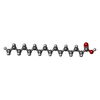
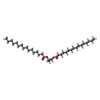

| #7: Chemical | ChemComp-PLM / |
|---|---|
| #8: Chemical | ChemComp-Z41 / ( |
-Details
| Has ligand of interest | N |
|---|---|
| Has protein modification | Y |
-Experimental details
-Experiment
| Experiment | Method: ELECTRON MICROSCOPY |
|---|---|
| EM experiment | Aggregation state: PARTICLE / 3D reconstruction method: single particle reconstruction |
- Sample preparation
Sample preparation
| Component | Name: Porphyromonas gingivalis BAM complex / Type: COMPLEX / Entity ID: #1-#6 / Source: RECOMBINANT | ||||||||||||||||||||
|---|---|---|---|---|---|---|---|---|---|---|---|---|---|---|---|---|---|---|---|---|---|
| Molecular weight | Experimental value: NO | ||||||||||||||||||||
| Source (natural) | Organism:  Porphyromonas gingivalis ATCC 33277 (bacteria) Porphyromonas gingivalis ATCC 33277 (bacteria) | ||||||||||||||||||||
| Source (recombinant) | Organism:  Porphyromonas gingivalis ATCC 33277 (bacteria) Porphyromonas gingivalis ATCC 33277 (bacteria) | ||||||||||||||||||||
| Buffer solution | pH: 8 | ||||||||||||||||||||
| Buffer component |
| ||||||||||||||||||||
| Specimen | Conc.: 4.9 mg/ml / Embedding applied: NO / Shadowing applied: NO / Staining applied: NO / Vitrification applied: YES | ||||||||||||||||||||
| Specimen support | Grid material: COPPER / Grid mesh size: 200 divisions/in. / Grid type: Quantifoil R2/1 | ||||||||||||||||||||
| Vitrification | Instrument: FEI VITROBOT MARK IV / Cryogen name: ETHANE / Humidity: 95 % / Chamber temperature: 277 K |
- Electron microscopy imaging
Electron microscopy imaging
| Experimental equipment |  Model: Titan Krios / Image courtesy: FEI Company |
|---|---|
| Microscopy | Model: TFS KRIOS |
| Electron gun | Electron source:  FIELD EMISSION GUN / Accelerating voltage: 300 kV / Illumination mode: FLOOD BEAM FIELD EMISSION GUN / Accelerating voltage: 300 kV / Illumination mode: FLOOD BEAM |
| Electron lens | Mode: BRIGHT FIELD / Nominal magnification: 105000 X / Nominal defocus max: 1500 nm / Nominal defocus min: 600 nm |
| Specimen holder | Cryogen: NITROGEN / Specimen holder model: FEI TITAN KRIOS AUTOGRID HOLDER |
| Image recording | Electron dose: 41.01 e/Å2 / Film or detector model: GATAN K3 BIOQUANTUM (6k x 4k) / Num. of real images: 11459 |
| EM imaging optics | Energyfilter name: GIF Bioquantum / Energyfilter slit width: 20 eV |
- Processing
Processing
| EM software |
| |||||||||||||||||||||||||||||||||||
|---|---|---|---|---|---|---|---|---|---|---|---|---|---|---|---|---|---|---|---|---|---|---|---|---|---|---|---|---|---|---|---|---|---|---|---|---|
| CTF correction | Type: PHASE FLIPPING AND AMPLITUDE CORRECTION | |||||||||||||||||||||||||||||||||||
| Symmetry | Point symmetry: C1 (asymmetric) | |||||||||||||||||||||||||||||||||||
| 3D reconstruction | Resolution: 3.24 Å / Resolution method: FSC 0.143 CUT-OFF / Num. of particles: 86584 / Algorithm: FOURIER SPACE / Num. of class averages: 1 / Symmetry type: POINT | |||||||||||||||||||||||||||||||||||
| Atomic model building | Protocol: RIGID BODY FIT / Space: REAL | |||||||||||||||||||||||||||||||||||
| Atomic model building |
|
 Movie
Movie Controller
Controller







 PDBj
PDBj
